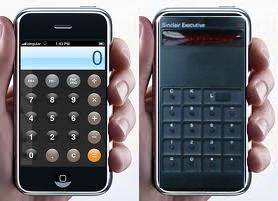The calumny of the Apple complaints against Samsung on the basis of alleged design infringement can best be understood by looking at the history of design in the general electronic sector of “hand-held” devices.
The first hand-held mobile phones (also called “cell phones” in the USA and, “handys” in Germany) had no displays and required “boxy” designs to accommodate the necessary but bulky state-of-the-art technology.
“Thin” was not then “in”, although that was the general direction of design development, to the degree permitted by technological advances and miniaturization of components, which allowed thinner designs.
As small displays became available, they were integrated into cell phones, which were then also outfitted with keyboards. That development finds a parallel design development in pocket calculators, which could be made “thinner” earlier in technological time because the technology was less demanding and allowed earlier, thinner miniaturization.
In fact, as written by Dylan Tweney at Wired.com, Gadget Lab, about the introduction of the iPhone in the year 1997:
“On Oyayubizoku, a blog whose name takes me about 60 seconds to type even though it only contains 11 letters, a terrific design tidbit: The iPhone’s calculator app is a clear tribute to the 1977 Braun ET44 and ET66 calculators. Beautiful.” [see the image below, text emphasis added by LawPundit]

Linked from the DesignMuseum.org, showing the ET44 of Dieter Rams
Did Apple design the iPhone based to a large degree on the prior art in pocket calculators? It sure looks like it. Compare the design and the colors of the buttons. What is the difference between “tribute” (a word used above) and “design copy”?

Note the sleek dark design of the Braun and the rounded bottom corners. Add a silvery frame and those two will look very similar. Indeed, we took the original Braun ET44 (viz. ET66) image at the right above, reduced it to 88% of the original and superimposed it on the iPhone, showing that the only real design difference is the silver rim and four rounded corners instead of two.
An even earlier design advance was the 5.5 x 2.25 x 0.4 inches flat black 1972 Sinclair Executive in rectangular form with rounded edges that is regarded to be the world’s first pocket calculator.

“The Executive was seen as a genuinely revolutionary advance (which in truth it was). Calculators prior to the Executive had been bulky, desk-bound affairs, often depending on mains power. The fundamental problem was the high power demands of the LED display: indeed, it was precisely that problem which drove the development of liquid crystal displays and ultimately killed off the LED-equipped calculators….
It was virtually the first attractively-styled calculator, its rivals and predecessors being utilitarian lumps of plastic. The neat design of the injection-moulded polycarbonate casing won its designer, Richard Torrens, the Design Council Award for Electronics in 1973. New Scientist described it as “not so much a professional calculator – more a piece of personal jewellery”. Design magazine called it “at once a conversation piece, a rich man’s plaything and a functional business machine”. It was even exhibited at the Museum of Modern Art in New York….”
In the image below we took the original Sinclair Executive image from above, reduced it to 75% of the original, truncated a bit of the bottom and then superimposed it on the iPhone, showing that the main difference between the two devices are the icons instead of button keys and Apples’s silver rim:
The Samsung I9000 Galaxy S is 4.82 x 2.53 x 0.39 inches. The image below is linked from AndroidNews.de which from the left shows the iPhone, the Samsung i9000 Galaxy S in the middle and the HTC Desire right, side-by-side:

The images show that new LCD-type viz. AMOLED or similar touch screens permit manufacturers to use virtually the full surface of the electronic device for display, with the display encased in a bezel (frame).
There is no longer a need to have smaller displays, previously mandated by the necessity of a mechanical keyboard, since the keyboard is now also electronic, and virtually integrated into the display.
This leaves only minimal opportunities for greatly diverging designs because only the edges around the display actually remain for design purposes.
We find the same phenomenon with TVs. Walk into a shop today and try to discern the design differences among the TVs. Those differences are very small since the screen takes up almost all of the visible surface.
Although it is clear that the Samsung i9000 Galaxy S has similarities to the iPhone, it is quite clearly an independent product that can be easily distinguised from an iPhone, which in turn is composed of many design elements that Apple itself did not create, but adapted from prior art.
There is absolutely no reason to issue any injunction of any kind against Samsung.
Quite the contrary, the design registrations of Apple should be revoked and voided.
And there is a lesson here for whoever doctored the images in the Apple design suits against Samsung. What you can do — we can do better.
The design infringement cases are dismissed!


